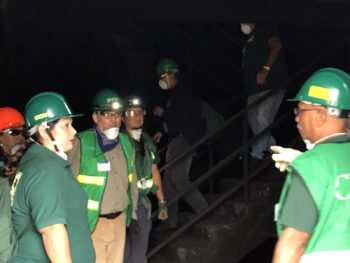A three-foot section of plastic pipe wrapped in foam and rigged with tubing squirted out red-tinged water to represent a bleeding thigh. Told to stop the “bleeding,” trained community members were instructed to apply direct pressure, then wrap it with bandages.
This was one of six stations offered to Community Emergency Response Team members to help them refresh skills that could save the lives of their family or neighbors in an emergency. The County Office of Emergency Services coordinated the training and offered it to all 31 CERT programs in the region. Of those programs, about 140 members from 16 teams took advantage of the opportunity held at the Heartland Fire Training Facility in El Cajon on May 19.

“We chose to focus on bleeding control just based on all the things that have been happening in the news,’” said Bill Leininger, one of the instructors for the medical operations bleeding control station and also a program manager for Palomar Mountain CERT. “This could be used for shootings or horrible car accidents and around San Diego County, there’s some industry in agriculture where you could have horrible bleeding accidents. And so knowing how to stop bleeding –either as part of CERT or just in their individual lives– is so effective at saving lives. In a matter of minutes it can make all the difference.”
Leininger said having the hands-on simulation teaches volunteers it’s not hard to do.
The other stations included classroom training in the Incident Command System used by emergency personnel and reviewing search and rescue missions, search and rescue and triage, fire safety – which included putting out small fires – and safely lifting heavy objects off people as a team.
In the last exercise, members lifted a concrete slab off a dummy. The goal was to lift it using metal digging bars and stabilize or prop it with pieces of wood. They were given tips on how to safely rescue the dummy without injuring themselves.
CERT members who participated in the training have all completed 24 hours of basic training in their jurisdiction as well as any additional training offered, sometimes on a monthly basis, sometimes less frequently. They are provided with a CERT backpack with some safety equipment, a hard hat and a green vest identifying them as CERT members.

Jeff Murdock, the CERT exercise director and Escondido Fire Emergency/Disaster Preparedness Manager, said it’s important for the volunteers to keep their skills sharp.
“If you don’t practice them regularly, you might not remember how to do a particular skill,” he said. “By refreshing them over and over again, we have the opportunity to practice and be more proficient for when the bad thing really happens.”
CERT members can be any resident who can commit to the basic training.
“For me, I just wanted to be aware and if there’s ever a need, I won’t panic in an emergency situation and I’ll know what to do,” said Darren Amerson, an engineer who joined Poway CERT a year ago.
Alma Verdugo, a gas station manager, said she and her mother are members of the National City CERT. She thinks it’s “awesome” and is inspired by the others who are willing to help their community.
“We live in a major earthquake area and we can have a tsunami, so it’s good to be ready and to prepare for emergencies,” said Verdugo. “If you’re not able to help others, at least you can help yourself.”

Murdock said the training would be valuable for all residents.
“We would love that all our residents had this basic training. When something large happens like a major earthquake, public safety is simply going to be maxed out and they’re not coming right away. And by everyone having this basic training they’re able to help their neighbors last a little bit longer,” Murdock said. “And when public safety does show up, it’s an easy handoff from them to public safety because they’ve had the training.”
To learn about how to become a CERT member, visit the county’s page to reach out to your local jurisdiction contact.






